Komainu
Komainu (狛犬), often called lion-dogs in English, are statue pairs of lion-like creatures either guarding the entrance or the honden, or inner shrine of many Japanese Shinto shrines or kept inside the inner shrine itself, where they are not visible to the public. The first type, born during the Edo period, is called sandō komainu (参道狛犬, visiting road Komainu), the second and much older type jinnai komainu (陣内狛犬, shrine inside komainu).[1] They can sometimes be found also at Buddhist temples, nobility residences or even private homes.
Symbolic meaning
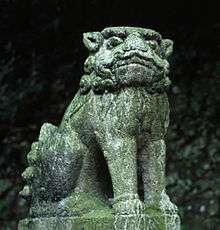
Meant to ward off evil spirits, modern komainu statues usually are almost identical, but one has the mouth open, the other closed (however, exceptions exist, where both komainu have their mouth either open or closed.[2]). The two forms are called a-gyō (阿形, lit. "a" shape) and un-gyō (吽形, lit. "un" shape) or referred to collectively as a-un.[3]
This is a very common characteristic in religious statue pairs at both temples and shrines. The pattern is Buddhist in origin (see the article about the Niō, human-form guardians of Buddhist temples) and has a symbolic meaning: The open mouth is pronouncing the first letter of the Sanskrit alphabet, which is pronounced "a", while the closed one is uttering the last letter, which is pronounced "um", to represent the beginning and the end of all things.[4] Together they form the sound Aum, a syllable sacred in several religions like Hinduism, Buddhism, and Jainism.
History
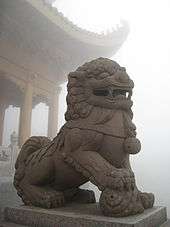
Komainu strongly resemble Chinese guardian lions and in fact originate from Tang dynasty China.[5] The Chinese guardian lions are believed to have been influenced by lion pelts and lion depictions introduced through trade from either the Middle East or India, countries where the lion existed and was a symbol of strength.[6] During its transportation along the Silkroad, however, the symbol changed, acquiring a distinctive look. The first lion statue in India appears around the 3rd century BC on top of a column erected by King Ashoka.[6] The tradition later arrived in China where it developed into the guardian lion that was later exported to Korea, Japan, and Okinawa.
During the Nara period (710–794), as in the rest of Asia, the pair always consisted of two lions.[7] Used only indoors until the 14th century, they were made mainly of wood. During the Heian period (794–1185), for example, wooden or metal pairs were employed as weights and door-stops, while at the Imperial Palace they were used to support screens or folding screens.
During the early Heian period (ninth century), the tradition changed and the two statues started to be different and be called differently. One had its mouth open and was called shishi (獅子, lion) because, as before, it resembled that animal. The other had its mouth closed, looked rather like a dog, was called komainu, or "Goguryeo dog", and sometimes had a single horn on its head.[8] Gradually the animals returned to be identical, but for their mouths, and ended up being called both komainu.[8]
Ubiquitous as they are now at shrines, Komainu have been used outdoors only since the 14th century.[7] In Asia, the lion was popularly believed to have the power to repel evil, and for this reason it was habitually used to guard gates and doors. In Japan, too it ended up being installed at the entrance of shrines and temples next to the lion-dog.[9] As a protection against exposure to Japan's rainy weather, the komainu started being carved in stone.
The shīsā (シーサー), the stone animals that in Okinawa guard the gates or the roofs of houses, are close relatives of the shishi and the komainu, objects whose origin, function and symbolic meaning they share.[10] Their name itself is centuries old regional variant of shishi-san (獅子さん, Mr. Lion).[3]
Starting from the Edo period (1603–1868) other animals have been used instead of lions or dogs, among others wild boars, tigers, dragons and foxes.
Foxes at Inari shrines
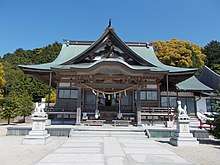
The most frequent variant of the komainu theme is the fox, guardian of shrines dedicated to kami Inari. There are about 30 thousand Inari shrines in Japan, and the entrance of each is guarded by a pair of fox statues.[11] Often one, and sometimes both, has a sūtra roll, a key or a jewel in its mouth (sūtras are Buddhist texts, a fact which attests to the Buddhist origins of the Inari cult[11][12]). The statues do not symbolize the animals' proverbial malice, but the magic powers they are believed to possess. Sometimes the guardians are painted, and in that case they are always white.[11] White foxes are messengers of the kami, who is sometimes himself believed to be, and portrayed as, a fox.[11] Although visible genitals are rare, the left fox is believed to be male, the right one female.[13]
Often the foxes wear red votive bibs similar to those worn by statues of other figures: for example, the Buddhist bodhisattva figure Jizō. In this case, however, the bibs seem to be purely a rite, whose origins are unclear.
Gallery
 A komainu with a horn on its head.
A komainu with a horn on its head. An Okinawan shīsā
An Okinawan shīsā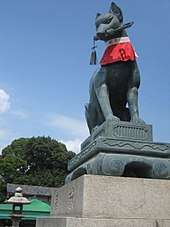 A fox in front of an Inari shrine with a key in its mouth
A fox in front of an Inari shrine with a key in its mouth Pair of fox guardians with kit at Numazu Aratama Inari Jinja
Pair of fox guardians with kit at Numazu Aratama Inari Jinja Detail view of the right fox guardian of the shrine Aratama Inari Jinja in Numazu with visible male genitalia
Detail view of the right fox guardian of the shrine Aratama Inari Jinja in Numazu with visible male genitalia Detail view of the left fox guardian of the shrine Aratama Inari Jinja in Numazu with kit
Detail view of the left fox guardian of the shrine Aratama Inari Jinja in Numazu with kit Komainu outside the gate of Saikouji in Toyohashi
Komainu outside the gate of Saikouji in Toyohashi Detail view of right Komainu outside the gate of Saikouji in Toyohashi with visible male genitalia
Detail view of right Komainu outside the gate of Saikouji in Toyohashi with visible male genitalia Detail view of left Komainu outside the gate of Saikouji in Toyohashi with cub
Detail view of left Komainu outside the gate of Saikouji in Toyohashi with cub A guardian wild boar
A guardian wild boar_Agyo-right.jpg) A guardian komatora (狛虎)
A guardian komatora (狛虎)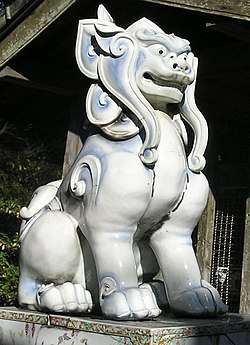
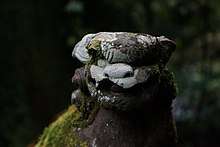 A komainu at Hakone Shrine
A komainu at Hakone Shrine
See also
![]()
Notes
- Kotera, pages 1 and 2
- Shogakukan Encyclopedia, Komainu
- Iwanami Kōjien (広辞苑) Japanese dictionary, 6th Edition (2008), DVD version
- JAANUS, A un, accessed on July 10, 2010
- Encyclopedia of Shinto, Komainu
- Shisa Travelogue, Culture of the lion around the world; roots of the shisa Archived October 9, 2009, at the Wayback Machine
- Kyoto National Museum Dictionary
- JAANUS, Komainu, accessed on July 16, 2010
- Shogakukan Encyclopedia, Shishi
- Shisa Travelogue, The Chinese lion-Guardian dogs Archived October 8, 2009, at the Wayback Machine
- Scheid, Inari Fuchswächter
- On the fusion of Shintō and Buddhism, see the article Shinbutsu shūgō
- Smyers (1999:229)
References
- "JAANUS". on-line Dictionary of Japanese Architectural and Art Historical Terminology.
- "Lion-dogs". Kyoto National Museum Dictionary. Retrieved 16 July 2010.
- Mihashi, Ken. "Komainu". Shogakukan Encyclopedia online (in Japanese). Yahoo. Retrieved 16 July 2010.
- Kanechiku, Nobuyuki. "Shishi" (in Japanese). Shogakukan Encyclopedia online. Retrieved 16 July 2010.
- Kotera, Yoshiaki. "Komainu" (PDF) (in Japanese). Japanese Religions. Archived from the original (PDF) on 19 July 2011. Retrieved 31 July 2010.
- Nakayama, Kaoru. "Komainu". Encyclopedia of Shinto. Kokugakuin University. Retrieved 27 December 2010.
- Scheid, Bernhard. "Inari Fuchswächter" (in German). University of Vienna. Retrieved 30 July 2010.
- "Shisa Travelogue". Okinawa Prefectural Government. Retrieved 18 July 2010.
- Smyers, Karen Ann (1999). The Fox and the Jewel: Shared and Private Meanings in Contemporary Japanese Inari Worship. Honolulu: University of Hawaii Press. ISBN 0-8248-2102-5. OCLC 231775156.
| Wikimedia Commons has media related to Komainu. |
